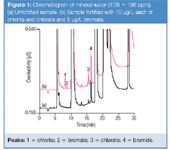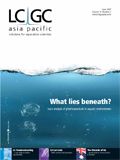Determination of Trace Concentrations of Bromate and Bromide in Natural Mineral Waters by Reagent-Free Ion Chromatography
LCGC Asia Pacific
Bottled water has emerged as one of the fastest growing and most dynamic beverage categories over the last five to ten years. In 2004, the US and global community consumed nearly 7 billion gallons and 41 billion gallons, respectively, according to the Beverage Marketing Association.1 Many bottled water companies prefer ozone as a disinfectant because it is one of the most effective disinfectants available. It does not alter the taste, and bottlers do not need to be concerned about leaving a residual disinfectant in water that is sealed in a container.2 Unfortunately, ozone can react with naturally occurring bromide in the source water to produce bromate, a potential human carcinogen. The US Food and Drug Administration (FDA) established a maximum permissible limit of 10 mg/L of bromate in bottled drinking water.3 However, the European Commission set a maximum permissible limit of 3 mg/L of bromate for natural mineral waters and spring waters treated by ozonation.4 In this paper, we describe the use of the hydroxide-selective IonPac AS19 column to determine trace concentrations of chlorite, bromate, chlorate, and bromide in natural mineral waters obtained from three European countries.
Experimental
An integrated Dionex ICS-2000 Reagent-Free Ion Chromatography (RFIC) system equipped with an EluGen EGC-KOH cartridge was used in this work. An IonPac AS19 (4 × 250 mm) with its respective guard column AG19 (4 × 50 mm) was used for all separations with a flow-rate of 1 mL/min. Analytes were detected by suppressed conductivity with an ASRS ULTRA II (4 mm) operating at 130 mA in the recycle mode. A 250 μL injection volume was used throughout. Chromeleon Chromatography Management Software was used for system control and data processing.
Results and Discussion
In the US, mineral water is defined as "water not containing less than 250 ppm total dissolved solids (TDS)".5 However, mineral water that originates from Europe can contain less than 50 ppm TDS.6 We evaluated three European mineral waters with TDS that varied from 136 to 2359 ppm using a hydroxide-selective IonPac AS19 column. Hydroxide eluents provide considerable advantage over carbonate eluents by producing significantly lower background conductivity and thereby lower baseline noise and lower detection limits. The AS19 column combined with an electrolytically generated hydroxide eluent enabled a method detection limit of 0.31 μg/L bromate and is therefore ideally suited to meet the current European regulatory requirement for bromate in mineral water. Figure 1(a) shows an example chromatogram of a European mineral water (TDS = 136 ppm) with no chlorite or bromate detected and < 5 μg/L chlorate. This bottled water manufacturer did not indicate that ozonation was used for disinfection and, therefore, bromate was not expected. However, this mineral water contained approximately 16 μg/L bromide indicating a potential for bromate production, if treated with ozone. Figure 1(b) shows the same sample spiked with 10 μg/L each of chlorite and chlorate and 5 μg/L bromate, resulting in recoveries in the range of 88–91%. An RFIC system equipped with an AS19 column easily, accurately and simultaneously determines bromate and bromide in mineral water at concentrations below the regulatory limits.

Figure 1
References
1. Rodwan, J.G. Reprint from The Bottled Water Reporter, Aug/May (2005). http://www.beveragemarketing.com/news3e.htm (accessed Nov 30, 2006).
2. Water Health Series: Bottled Water Basics; US Environmental Protection Agency, US Government Printing Office: Washington, DC, USA, Sept (2005).
3. Fed. Reg., 66(60), 16858 (2001).
4. Establishing the list, concentration limits and labelling requirements for the constituents of natural mineral waters and the conditions for using ozone-enriched air for the treatment of natural mineral waters and spring waters; European Parliament and Council Directive No. 2003/40/EC (2003).
5. L.M. Posnick and K. Henry, Food Safety Magazine, Aug/Sept (2002).
6. The Approximation of the Laws of the Member States Relating to the Exploitation and Marketing of Natural Mineral Waters; European Parliament and Council Directive No. 80/777/EEC (1980).

Dionex Corporation
1228 Titan Way, P.O. Box 3603, Sunnyvale,
California 94088-3603, USA
tel. +1 408 737 0700 fax +1 408 730 9403
Website: www.dionex.com

The Benefits of Custom Bonded Silica
April 1st 2025Not all chromatography resins are created equal. Off-the-shelf chromatography resins might not always meet the rigorous purification requirements of biopharmaceutical manufacturing. Custom bonded silica from Grace can address a wide range of separation challenges, leading to real performance improvements. Discover more about the latest innovations in chromatography silica from Grace, including VYDAC® and DAVISIL®.
5 Things to Consider When Selecting a Chromatography Silica
April 1st 2025Particularly in the pharmaceutical industry, drug purity isn’t just a goal – it’s essential for achieving safety, stability and efficacy. However, purification is easier said than done, especially with challenging molecules like DNA and RNA “oligonucleotides,” due in large part to their diversity and the range of impurities that can be generated during production. Enter DAVISIL® chromatographic silica, with a wide range of pore diameters and particle sizes to meet your specific application, performance and sustainability requirements. Before you choose the chromatography resin for your next purification application, take a look at these 5 considerations.
Automating Protein Purification: Efficiency, Yield, and Reproducibility
March 27th 2025Recent advancements in automated protein purification stress the importance of efficiency, scalability, and yield consistency. This eBook compares different purification platforms, highlighting their impact on downstream applications and demonstrating how automation enhances throughput and process control.
MilliporeSigma: Ultrapure Water for Sensitive LC-MS Analysis of Pesticides
March 25th 2025The aim of the study was to illustrate the efficiency of Milli-Q® water purification systems in eliminating pesticides from tap water, thereby producing and delivering reliable and consistent-quality ultrapure water suitable for pesticides analysis



















